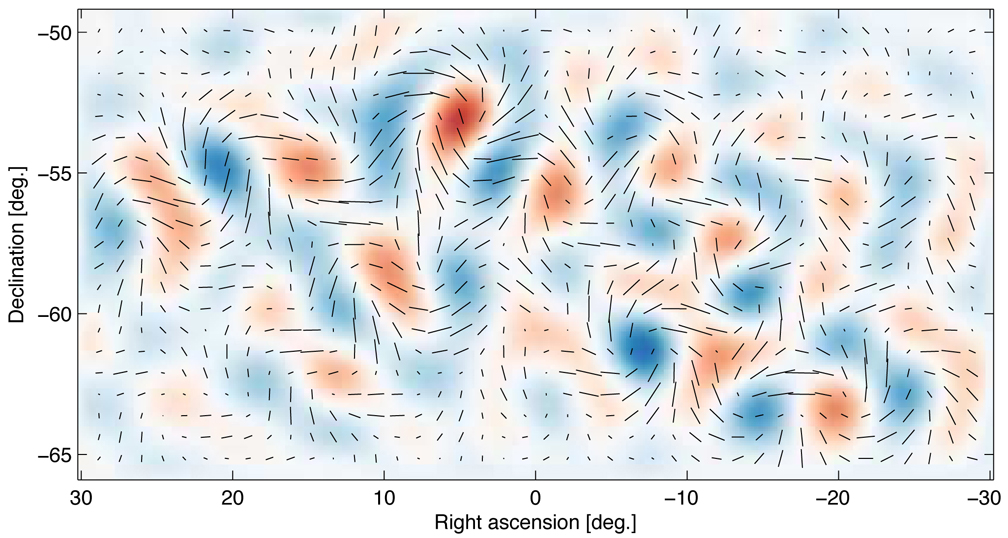Last month, scientists announced the first hard evidence for cosmic inflation, the process by which the infant universe swelled from microscopic to cosmic size in an instant.
While this almost unimaginably fast expansion was theorized more than three decades ago, there had been no evidence. Then researchers from the BICEP2 collaboration announced the first direct evidence for cosmic inflation and the first images of gravitational waves, or ripples in space-time, described as the "first tremors of the Big Bang."
The theoretical community is abuzz but that isn't meaningful to the public; theorists also get excited about time travel and then say it's up to experimental physicists to make it happen. What does it mean for our understanding of the universe?

What does it mean, though? Gravitational waves from inflation generate a faint but distinctive twisting pattern in the polarization of the cosmic microwave background, known as a "curl" or B-mode pattern. For the density fluctuations that generate most of the polarization of the CMB, this part of the primordial pattern is exactly zero. Shown here is the actual B-mode pattern observed with the BICEP2 telescope, which is consistent with the pattern predicted for primordial gravitational waves. The line segments show the polarization strength and orientation at different spots on the sky. The red and blue shading shows the degree of clockwise and anti-clockwise twisting of this B-mode pattern. Credit: Harvard-Smithsonian Center For Astrophysics, BICEP2
Walter Ogburn, a postdoctoral researcher at the Kavli Institute for Particle Astrophysics and Cosmology at Stanford University, and a member of the discovery team, says the exciting thing "is not just confirming that inflation happened— many of us already had a pretty good idea that was likely to be the case—but having a chance to figure out exactly how it happened, what it was that drove it, whether there are new particles and new fields that participated in it, and which of the many models could be correct."
That's made possible by the strength of the detected signal. Far from the quiet whisper that many expected, the signal turned out to be a relatively loud drone. That brings with it many implications.
It's already clear that the result rules out many hypothetical models of inflation - most of them, in fact, so many that using the word 'theory' ruins the word for people who think a theory is solid science, like the theory of gravity or evolution - and those hypotheses are in jeopardy because they predicted a signal much weaker than the one detected. In addition, the discovery also seems to disprove the hypothesis that says that the universe expands, collapses and expands again in an ongoing cycle.
More than that, the result could very well be what theorist Michael S. Turner, theoretical physicist at the University of Chicago, calls a "crack in the cosmic egg," offering clues that even the most accepted assumptions contain inaccuracies.
"There have been hints for a while now that maybe something else is going on," says Kavli Institute for Cosmological Physics Deputy Director John Carlstrom, who leads two other experiments that study the universe's first light. "Maybe we need to… allow some new physics in there. Maybe there are more neutrinos. Maybe they're more massive than we thought. Or maybe it's something none of us have thought of yet."
Theorist physicists can come up with suitably cosmic scenarios all they want but the signal still needs to be experimentally confirmed. Results from other telescopes, including the Planck satellite and the South Pole Telescope, are expected in the coming year. After that, the next step will be to carefully measure the characteristics of the signal, searching for evidence of how inflation took place and how exactly the universe worked in its high-energy infancy.
Those results may shed light on some of our biggest questions about how the universe began and how the forces of nature are unified.
"It's a funny thing when you're on the inside of a discovery like this," says Abigail Vieregg, a professor at the University of Chicago. "It's only when you release the results to the world and watch the reaction of the community that, at least for me, it really hits home how important it is. If this is what we think it is, it's a very big deal."





Comments